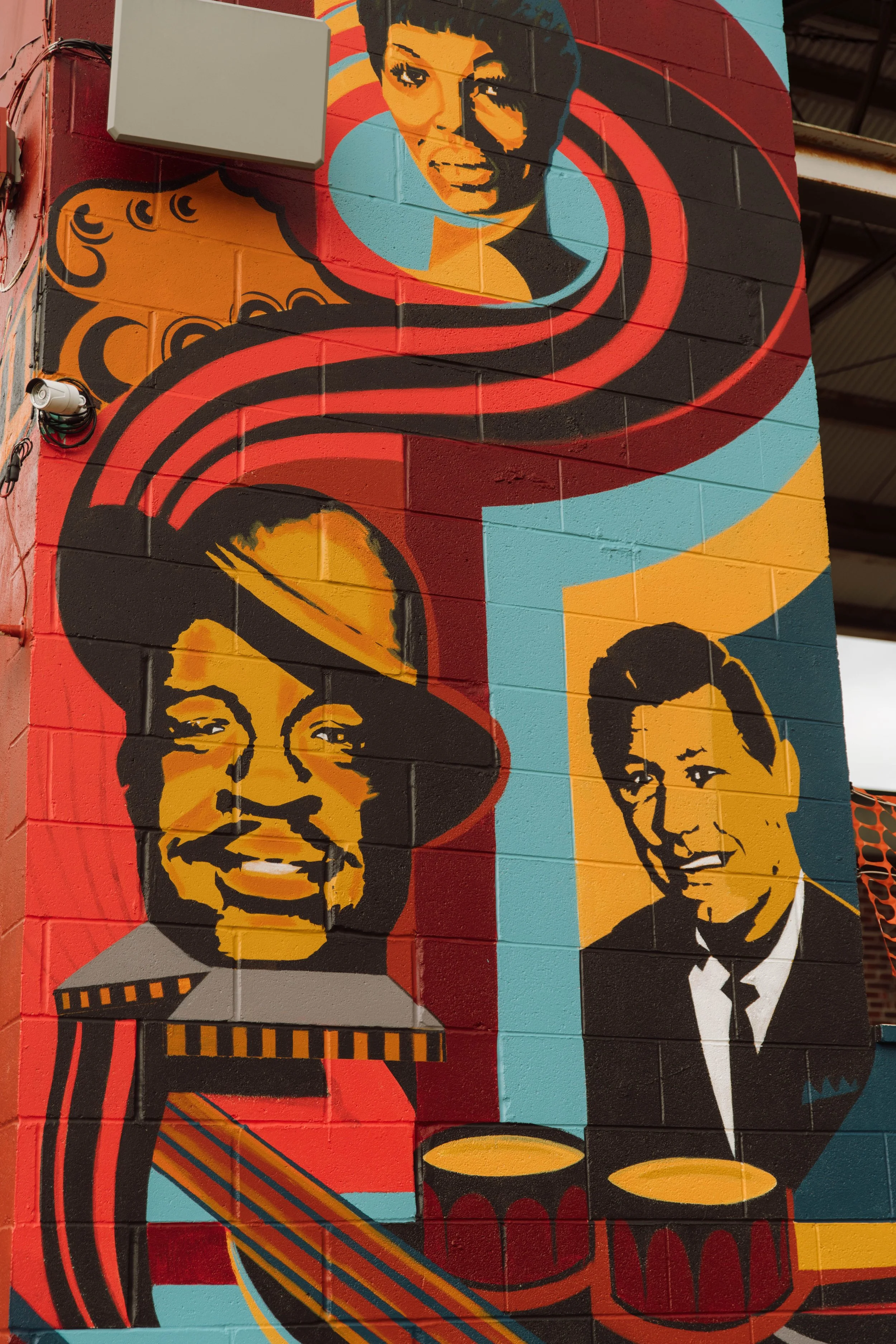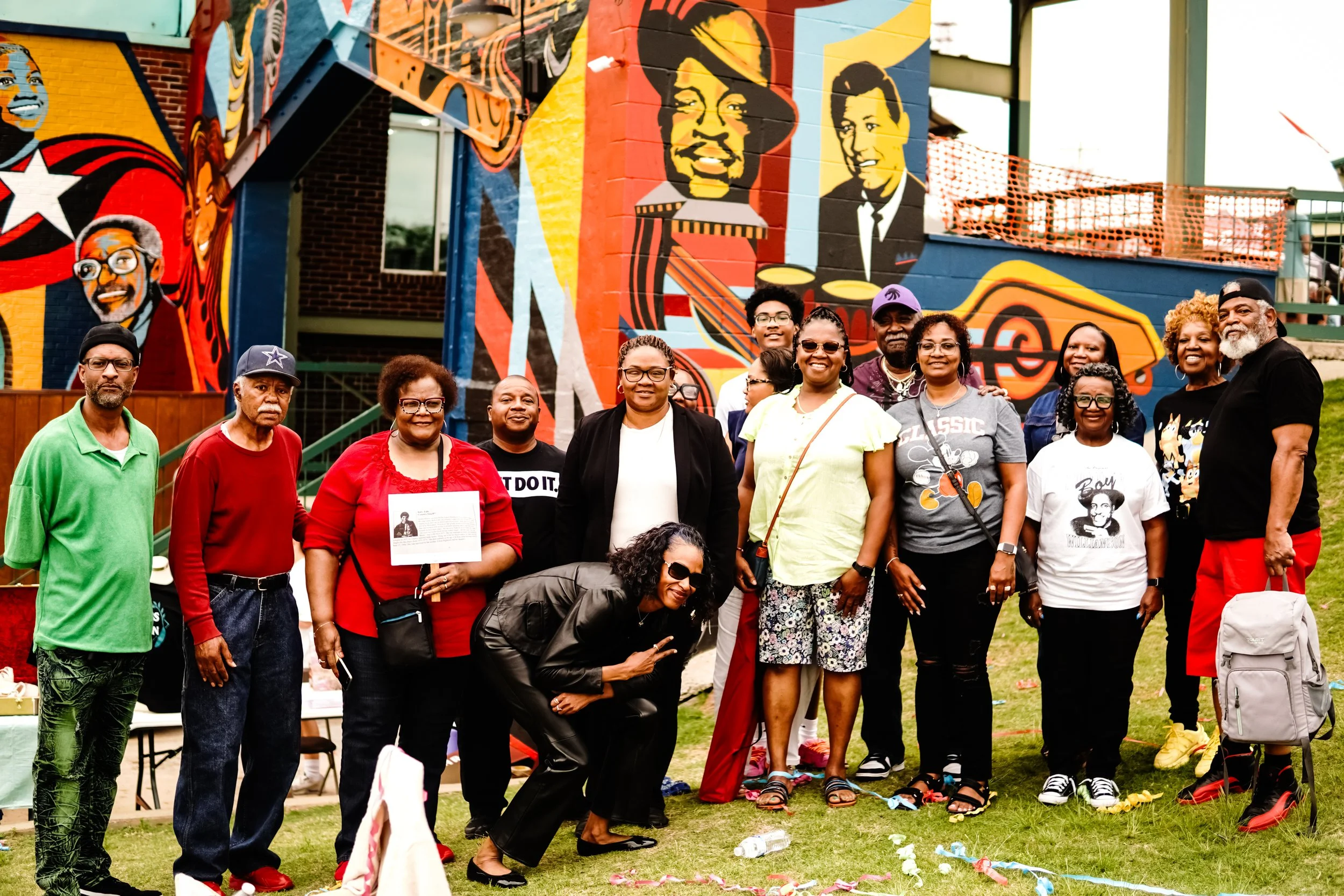Shaping the Musical Climate: The History Behind Jackson's AMP Mural Musicians
Written by Gabe Hart
Photos by Maddie McMurry and Hannah Gore
On Friday nights - when the air is warmer and the sun hesitant to disappear over the horizon - a crowd gathers in downtown Jackson for a weekly worship service. Children dance; parents sing; guitar riffs reverberate across a painted sky. This ain’t a tent revival, though; it’s just another Friday night at The Amp.
From late spring to early fall, The Amp in downtown Jackson is home to the communal rollicking of Jacksonians to the sounds of West Tennessee bands. From hip-hop to country to rhythm and blues, the music shimmering in the bowl of the natural amphitheater is a tapestry of musical history shaped and refined in the Hub City.
On the Northwest facade of the outer wall of the stage, a bold mural showcasing eight musicians - the original lissiers of Jackson’s diverse soundscape - faces south, buttressing the present and future of live music in Jackson.
The mural, Jackson Legends, features eight musical artists with Jackson roots who helped shape the musical climate of their time. They were pioneers and trailblazers during a formative period in southern culture when resistance and resilience walked hand in hand with artistic creativity.
Rodger Jowers, local music historian and advisor for the mural project, said that a common thread running through each selection was one of a pioneering spirit - a spirit that led to the reshaping of both popular and musical culture of the time while being rooted in Jackson.
Gil Scott-Heron. Big Maybelle. Joe Hunter. Denise LaSalle. Ruby Falls. Sonny Boy Williamson I. W.S Holland. Carl Perkins.
These artists brought a specific style and flavor to the music industry, forever changing their respective genres. Their bold sense of voice and unbending focus rattled the industry and carved a path forward for future generations of artists who may have never had access to a map without the trailblazing done before their time.
No one in the mural personified resistance as much as Gil Scott-Heron. A poet, musician, and author, Scott-Heron lived in Jackson until he turned 12 years old, when he headed to the Bronx to live with his mother. There, he began to shape his creative worldview, drawing literary influence from Langston Hughes as well as the Black Arts Movement. He was eventually inducted into the Rock and Roll Hall of Fame after his death.
“The OG rappers call him the Godfather,” Jowers explained. “Gil grew up to be a poet who experimented with combining his spoken word poetry with music and laid the foundation for rap.”
If there were an artist on the mural whose style was a foil to Scott-Herron’s spoken-word, linguistic vibe, it would be Big Maybelle.
Maybelle’s Jackson roots undoubtedly influenced her gospel style. The energy and volume of her voice were impossible to ignore. She recorded “Whole Lotta Shakin’ Goin On” - the lyrics sharply cutting through the vibrant rhythm and blues sounds - two years before Jerry Lee Lewis, and had a record produced by the legendary Quincy Jones.
Like Gil Scott-Heron, Joe Hunter spent just over a decade in Jackson. At 11, his family moved to Detroit; the rest is history.
Raised on the backbeat sounds of Motor City music, Hunter played in the Army Jazz band before eventually signing with Motown Records as the director of their house band. Hunter’s imprint was far and wide in Motown Sound, even influencing the style of Stevie Wonder.
Unlike the artists mentioned above, Denise LaSalle didn’t spend her early years in Jackson; she moved to the Hub City during the prime of her career.
In many ways, LaSalle’s music weaves the soulfulness of gospel and R&B with the elongated melodies of country music. The instrumental intro to her 1984 hit “Right Place, Right Time” could easily fit into a Patsy Cline or Mickey Newbury tune on country radio in the 1970s.
LaSalle remained in Jackson until her death in 2018, and her influence on music in the Southern Delta is inarguable.
Because multiple genres of music have proliferated due to the streaming sites of the modern era, it can be difficult to classify specific songs or artists. Throughout southern culture, multiple genres existed separately but also had a way of fusing certain aspects. Southern music, in many ways, is the inverted hope of the effects of the region’s poisonous history - a blending of race, culture, pain, and hope - to produce a sound that is both celebratory and gritty. A sound that still echoes throughout our city.
The music scene in any part of Tennessee - West, Middle, or East - can’t be discussed without including country music. While country music may not have been born in Tennessee, it certainly has been raised here. And, like many southern institutions, it took its turn at keeping certain people out of that club. Even today, minorities in country music are few and far between, but that didn’t stop Ruby Falls from trailblazing her path into a space where many people who looked like her were excluded.
Ruby was born Bertha Bearden Dorsey in Jackson, Tennessee, but later moved to Milwaukee, where she began fronting local bands. Just as Charley Pride finished kicking in country music’s exclusive door, Ruby moved to Nashville in 1974 and immediately started recording singles and gaining respect and admiration for her vocal talents. She was eventually nominated for the Most Promising Female Vocalist award in 1975, proving how much she belonged in Nashville.
While the style of Ruby Falls was unmistakably country, Sonny Boy Williamson was a bluesman in every way.
Born in Jackson, Sonny Boy moved to Chicago and immediately immersed himself in the blues scene of the Windy City. If Gil Scott-Heron was the godfather of rap, then Sonny Boy was an elder statesman of the blues.
“Sonny Boy moved to Chicago from his Jackson childhood home and earned his chops as one of the grandfathers of the Chicago style blues, and the person who made the harmonica a signature of the sound,” Rodger said before adding “he has been a musician admired and emulated by generations of other musicians.”
The final two musicians featured on the northwest column of the Amp stage are inextricably connected.
W.S. Holland and Carl Perkins helped fully curate the sounds of what became known as Rockabilly music. With its forceful backbeats, edgy vocals, and driving rhythms, the genre became an anthem reflecting southern culture's inherent rebellious nature. The sharp twang of the guitar, a crisp slap on an upright bass, and a two and a four on the drums helped Rockabilly explode into the delta.
Holland was the drummer in Perkins’s first band and the percussionist on the original recording of “Blue Suede Shoes.” While with Perkins, Holland was introduced to Johnny Cash and joined Cash for the next four decades, helping to shape and define country music’s Outlaw Era.
Perkins, the artist most associated with the Hub City, is arguably one of the most influential musicians of the 20th century. Apart from pioneering the Rockabilly sound, Perkins’s songs were recorded by two of the highest-grossing artists in music history: Elvis Presley and The Beatles.
Just west of the West Tennessee Farmer’s Market pavilion is a hill adjacent to the outer walls of the Amp’s stage. From here, the Jackson Legends watch over the Friday night concerts like gods on Olympus - ever-present reminders that the music being performed on the stage beneath them also contains pieces of who they were while they were here.
An ever-present dichotomy in nearly every song is the idea of repetition while simultaneously progressing. In any given song, a beat will repeat and a chorus will be duplicated, but the narrative will push forward, constantly evolving until the end. The music scene in Jackson is much the same: influences from the past shaping the future one Friday night at a time.






